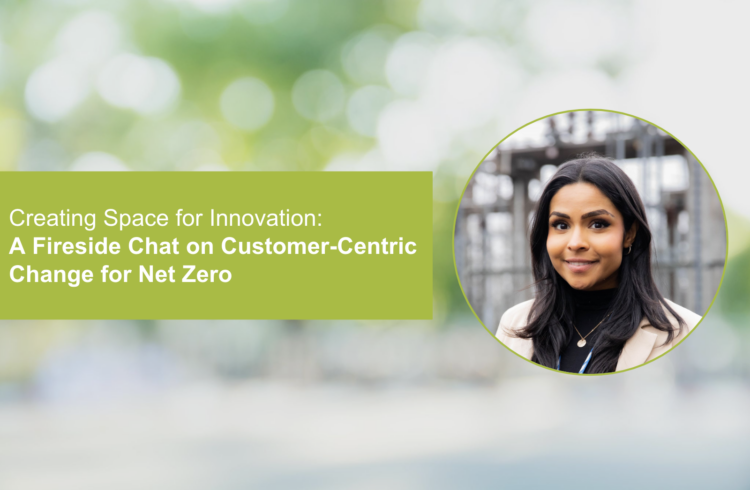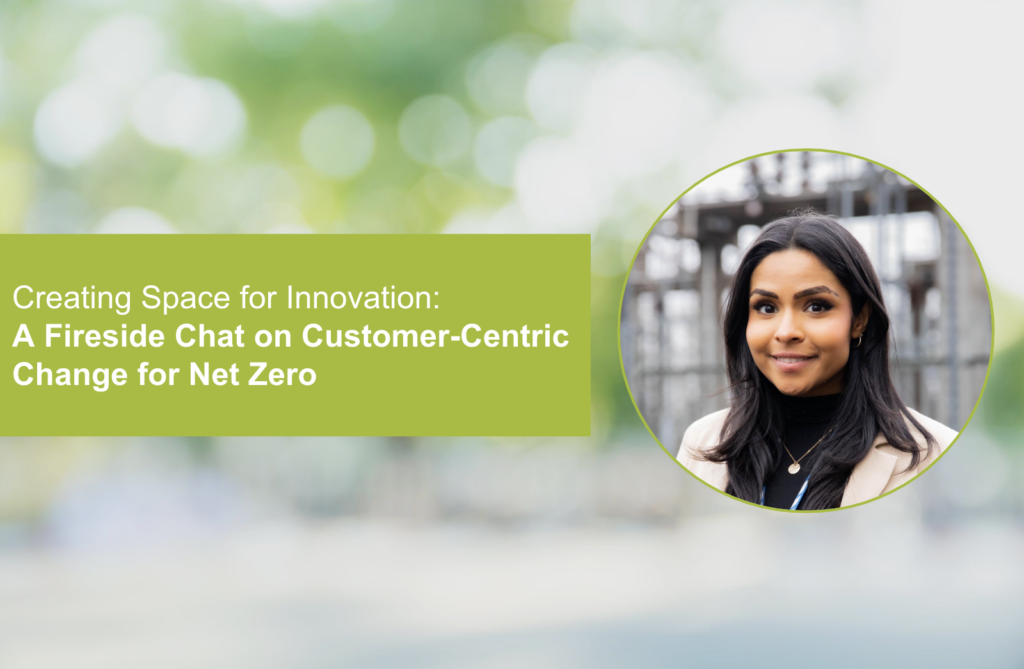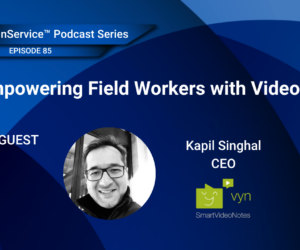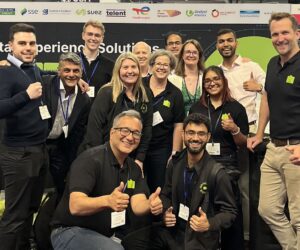
We met with Niki Kesharaju, Senior Manager for Heat Decarbonisation at National Grid, for a fireside chat on how to create innovation, leverage digital technologies to drive operations, navigate change management challenges and more.

Niki, could you please tell us a little bit about yourself?
I’m Niki, a Senior Manager in the Group Strategy team at National Grid leading on Heat Decarbonisation – from strategy, policy and stakeholder engagement, to answering the key question of ‘what will the impact on the grid be as we move towards electrified heat?’.
As the Senior Manager for Heat Decarbonisation at National Grid, you are at the forefront of some substantial change in the energy sector. Can you tell us more about your role?
The way that we currently heat our homes needs to fundamentally change as we move towards a net zero future. In the UK, we need to decarbonise heat in around 20,000 homes per week to achieve the targets that we’ve set ourselves. We’re moving away from natural gas boilers and a central heating system to potentially electrified heat. Using technology like heat pumps will be much more commonplace in our homes. Currently, space heating accounts for about 18% of the UK’s annual end-use carbon emissions. This is quite sizable. To achieve net zero, we need to think about how we do things differently and take our consumers along on the journey with us. But more importantly, from a National Grid side, we need to ensure that we’re prepared for this change in the way that homes are heated.
“To achieve Net Zero, we need to think about how we do things differently and take our consumers along on the journey with us. In the UK, we need to decarbonise around 20,000 homes per week to achieve the targets that we’ve set ourselves.”
Can you tell us about the personal purpose that drew you towards the challenge of Heat Decarbonisation and what inspired you to pursue this career path?
We’re in the midst of climate change news just about anywhere and everywhere. It’s important for me to ensure that I’m part of this clean, fair and affordable energy future. My goal is to make sure that our future generations have a planet to live in that they’re proud to call home and that allows them to thrive and make the most of everything that the world has to offer.
“We need to move towards a decarbonised future, but do it in a way that takes everyone along on the journey. Making an impact is right at the forefront of everything that I do and it’s why I’m in this role around Heat Decarbonisation – to be part of that broader transformation to effectively achieve net zero by 2050.”
I’ve always been interested in science, technology, engineering and maths. I’m an engineer by degree and I’ve always found the way that things work interesting. The thing that attracts me about technologies is that there’s thousands of technologies out there – but what’s the right application for the right technology? It’s not only about understanding the technology in its core engineering sense, but also its strategic and commercial implications. Why do some technologies win out over others? What’s the role of the consumer? How does a consumer feel about a particular type of technology? What are some of the commercial implications? Is it affordable? Is it the right thing to do from a broader net zero and affordability perspective? What’s the role of the government in policy when it comes to technology uptake? How do we do this in a way that is equitable? Answering the question of what makes some technologies win out over others is what’s got me interested in the role that I’m in at the moment.
After studying engineering at university, I stepped into the automotive sector as a bright eyed young graduate. As a materials engineer by degree, it made most sense for me to look at the material selection involved in car body structures. I soon realised that I wanted to do something that was more sustainability focused – which brought me over to National Grid. The underlying theme running throughout my career has been decarbonisation and clean technologies.
I started off in Capital Delivery, the construction side of the business, where I worked on low carbon construction, looking at how we decarbonise the way we build our assets. I then moved over to National Grid Partners, National Grid’s venture investment arm, where I was a Business Development Manager, looking at how we bring innovative technologies from the startup ecosystem into core business units and drive value and achieve strategic priorities. This brings me to my current role in Group Strategy, leading on Heat Decarbonisation.
Digitalisation is transforming every sector, including energy. In both your previous role as Business Development Manager at National Grid Partners, the company’s corporate venture and innovation unit, and your current role in Heat Decarbonisation, how have you leveraged digital technologies to drive operations? What potential do you see in these technologies for future sustainability efforts?
Digitalisation was at the heart of my previous role as Business Development Manager at National Grid Partners. We looked at startup technologies to create a space for innovation in National Grid’s core operations. We considered numerous technologies, covering different use cases. For instance, cybersecurity of our operational technology; subsurface mapping technologies to better conduct underground surveys; and low-carbon concrete. We also looked at grid-enhancing technologies, addressing the challenge of how we increase capacity on the grid.
The key was to drive value and benefit to business units. One particular example that stands out is with Vyntelligence (Vyn). We’d been talking to a business unit about a digitalisation need, and when we subsequently were introduced to Vyn, we realised their solution could be a fit for planning surveys across our overhead transmission lines. We used Vyn as a data capturing tool to get the best information as true to what we’re seeing out there in a digital form that makes data more accessible. I was able to follow this project right through from the start when it was just a conversation with a few business unit stakeholders and create space for Vyn to be trialled out on our sites and look to provide benefits not only to the business units, but their stakeholders as well. They were able to use the data that we captured using Vyn into their own activities and to achieve their own goals.
“We used Vyn as a data capturing tool to get the best information as true to what we’re seeing out there in a digital form that makes data more accessible.”
Given the scale and pace of the energy transition, particularly the role that National Grid has to play to accelerate the transition, we need digitalisation at the core.
In my current role, it’s more strategic. Here, I am looking to understand business and service model based innovation. How can the start to end journey for a consumer looking to transition away from a gas boiler into a heat pump be made easier? Technology needs to create that one stop shop user experience, focused on customer journey and experience. Some examples of heat decarbonisation innovation are using thermal infrared-based imagery on heat loss from buildings; and developing more innovative service models like heat as a service, which looks at smarter cloud-based ways to adjust heat pump usage profiles. The end goal is to meet customer satisfaction levels.
There’s lots of scope for digitalisation all around, and it’s truly exciting to be part of this. I’m always open to looking at more ways to bring digitalisation all the way through National Grid.
“We need to build five times the amount of electricity transmission infrastructure in the next seven years than we’ve done in the past 30. Digitalisation is key in achieving that.”
What are some of the challenges you face in driving innovation of this sort?
Innovation needs a safe space to trial out technology for the future. I wouldn’t call it a challenge, but one of the things that I come across in my role is how we can create the space to drive innovation and change.
Step one of innovation is to understand what your customer needs. I spend most of my time looking at what my business units need from me – what are their current priorities? What are some big strategic questions that they’re grappling with? What are their current pain points that they need technology to improve on? You start there, because you know there’s a need to solve a particular problem.
Then we scan the market for innovative technologies that have a clear but unique value proposition. It is important to frame it in a way that is beneficial to the customer and lets them almost immediately hone in on the value that this new technology is going to bring to them.
It’s also important to have empowered teams. And that means having empowered leaders who are able to have those initial handshakes to create buy-in. We did that day in and day out in my role at National Grid Partners. For Vyn, we made sure that we had the right handshakes with the right business units that immediately saw the benefit Vyn could bring to them. As soon as they realise the opportunity there, it creates space to trial out technology and move away from the status quo.
With that in mind, innovation finally needs a time-bound, outcomes-driven and hypothesis-led approach. It’s about ring fencing a small period of time, no more than a couple of months, for instance, and a small pot of money. It’s important to create that to allow some kind of hypothesis to be tested on the outcomes you’re looking to drive.
“Creating the space for innovation needs a time-bound, outcomes-driven and hypothesis-led approach.”
In Vyn’s case, it was to see if we could create efficiencies in how quickly we conduct our planning surveys that are a year ahead. Can we make this data we capture on video and audio transparent? Can we share it across other teams, which not only saves them visiting sites and the associated carbon emissions, but also helps teams function more efficiently? The trial was a couple of weeks. That was absolutely crucial in people getting to grips with a new technology and understanding the outcomes to test out and the known risks that we could manage.
Once you have the answers to some of those key questions, it’s about ensuring procurement is set up in the right place. You can now move these innovative technologies from the trial and proof of concept space into full deployment. That is key to driving innovation and change.
Change often encounters resistance, especially when it requires shifting long established practices. Can you share some strategies you have used to get buy-in from different stakeholders?
It is a coalition of the willing. It’s not about the change that’s being implemented, it’s about the hearts and minds that sit behind it. Focus on the people that have the expertise, resources and vested interest to solve the problem. Create the space to test it out and trial it. These people are powerful allies in communicating the benefits of change not only within their own circles, but also up and across the chain. Having them be part of the change journey is absolutely critical.
“The people that have the expertise, resources and vested interest to solve the problem are powerful allies in communicating the benefits of change not only within their own circles, but also up and across the chain. Having them be part of the change journey is absolutely critical.”
With Vyn, this happened without a lot of effort, because as soon as the people using Vyn to conduct their planning surveys were seeing the benefit, they did a lot of the communicating. They communicated the benefits to their stakeholder teams, and together we sat down and looked at how this technology can create benefits for teams that sit on the fringe of this particular use case. It’s a collective benefit that helps battle resistance. You might find that all you need to achieve change is one willing person and a few interested people to back them up.
Create a time-bound period and a safe space to trial out the innovation and know what you’re going to test. From a benefits perspective, the value proposition is important. Once you know that your technology is going to drive that initial hypothesised set of outcomes, you have evidence to convince the next set of stakeholders that might be on the fence about the change you’re trying to implement.
Finally, don’t be afraid of failing fast. Change is all about failing sometimes and succeeding sometimes. It’s about bringing people along with you and not being afraid to leave things behind if they’re not driving the outcomes that everyone’s bought into.
What advice would you give to other professionals aspiring to influence change within their organisations?
- Influencing change is all about bringing people on the journey with you. Empower your teams to see the benefit of the change and provide context and guidance where it’s most important.
- Innovation involves risk. Provide assurances and a safe place where people can air their concerns and questions and have them be addressed transparently.
- Focus on who is going to be the customer of the change. Always have that customer-focused perspective on any type of change or transformation initiative you’re trying to drive, because that focus will tell you a lot of the answers that you need to hear.
Interested in our previous fireside chats? Click here



